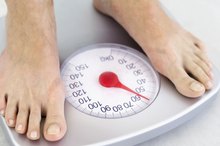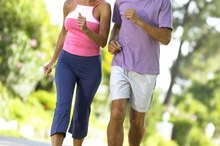Poor Blood Circulation & Running
If your hands and feet are cold to the touch, it doesn't mean you've got a cold heart. The more likely explanation is that your circulation isn't pumping effectively through your extremities. While you may write it off as a minor characteristic, the poor circulation causing differences in your skin temperature can suggest other health concerns that need to be treated. One way to improve your circulation is through exercises like running.
Identification
Poor circulation can be evident through several different symptoms. Pain in the locations may occur when active and subside during rest periods. Fatigue and heaviness due to poor oxygen supply in areas where circulation is inefficient may occur. You may also experience cramping and discomfort in your legs when exercising or even when walking or climbing stairs.
- Poor circulation can be evident through several different symptoms.
- Fatigue and heaviness due to poor oxygen supply in areas where circulation is inefficient may occur.
Poor Circulation Causes
Importance of Heart Health
Learn More
A common and serious cause of poor circulation is peripheral arterial disease, which narrows the blood vessels outside the heart with fat and cholesterol buildup. Peripheral arterial disease can sometimes be a precursor to heart attacks if it is left untreated. Typically, the reduction in your strength of circulation affects the legs more prominently, although the arms can also be affected. In serious circumstances, extremely blocked flows can choke out your tissues and lead to tissue death, even forcing the amputation of an arm or leg. A weak heart can also make it difficult for blood to reach the extremities.
- A common and serious cause of poor circulation is peripheral arterial disease, which narrows the blood vessels outside the heart with fat and cholesterol buildup.
- In serious circumstances, extremely blocked flows can choke out your tissues and lead to tissue death, even forcing the amputation of an arm or leg.
Effects of Running
Running, like many aerobic exercises, can stimulate the heart and circulation, improving blood flow throughout your body and to the extremities. But running can also yield significant improvements to your heart and circulatory system in several long-term ways, including lowering your blood cholesterol and blood pressure levels. Over time, this can lead to improvements in your body's circulation and reduce the risk of conditions like peripheral arterial disease.
Considerations
Heart Palpitations in Running
Learn More
Exercise can be very helpful to treating poor blood circulation, but it is also important that the cause of your circulation problems be treated in order to effect change and prevent future complications. For this reason, you should consult a doctor and have your poor circulation examined to determine the exact cause. If you have other heart or circulatory problems, such as high blood pressure or high cholesterol, talk to your doctor to make sure running is a safe activity for your body.
Related Articles
References
Writer Bio
Jonathan Croswell has spent more than five years writing and editing for a number of newspapers and online publications, including the "Omaha World-Herald" and "New York Newsday." Croswell received a Bachelor of Arts degree in English from the University of Nebraska and is currently pursuing a Master's of Health and Exercise Science at Portland State University.







